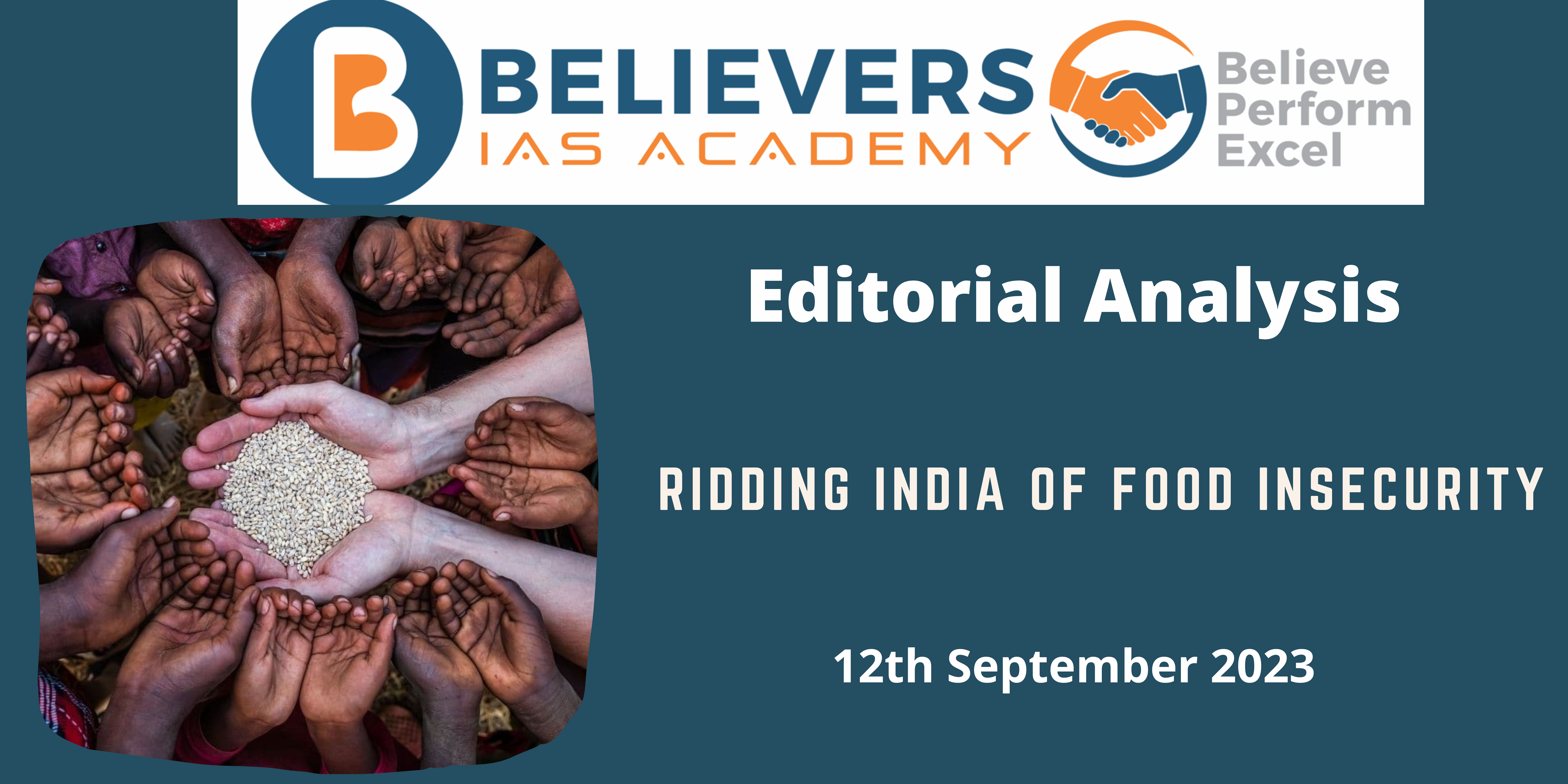Ridding India of food insecurity
Context:
The article addresses the pressing issue of food-price inflation in India, which has been on the rise despite the country’s status as one of the fastest-growing economies globally. It highlights concerns about the affordability of a nutritious diet for a significant portion of the population and calls for intervention to ensure food security.
Relevance:
GS-03 (Indian Economy)
Mains Question:
How can India tackle the challenge of rising food-price inflation and ensure that a healthy diet remains affordable for its vast population? (150 words)
Dimensions of the Article:
- The Escalation of Food-Price Inflation
- Alarming Findings on Affordability
- Understanding the Implications
- The Failure of Macroeconomic Policy
- The Green Revolution’s Significance
- Learning from Past Successes and Mistakes
- Key Initiatives
- The Role of States
- An Open-Minded Approach
The Escalation of Food-Price Inflation:
- While India boasts rapid economic growth, it grapples with an increasingly alarming problem: food-price inflation. This surge in the cost of food has been noticeable since 2019, persisting throughout subsequent years.
- In July of the current year, the annual inflation rate exceeded 11%, marking the highest level in the past ten years. This relentless increase in food prices threatens the ability of a substantial portion of the population to access nutritionally adequate food.
Alarming Findings on Affordability:
- A startling revelation comes from the Food and Agriculture Organization’s (FAO) report titled ‘State of Food Security and Nutrition in the World,’ indicating that a staggering 74% of India’s population cannot afford a healthy diet as of 2021.
- Given India’s vast population of 1.4 billion, this translates to approximately one billion individuals struggling to afford essential nutrition. This concerning trend is further corroborated by studies conducted within India, demonstrating a diminishing capacity of households to finance their food needs.
Understanding the Implications:
- A study, focusing on the price of food in Mumbai from 2018 to 2023, found that while the cost of preparing a typical meal at home increased by 65%, the average wages of both manual and salaried workers grew at comparatively slower rates of 38% and 28%, respectively. This disparity between rising food costs and income growth results in a significant decline in purchasing power, inevitably impacting food consumption.
- Furthermore, reports of increasing rates of anaemia, largely attributed to nutrient deficiencies, in the National Family Health Survey conducted from 2019 to 2021 underscore the FAO’s findings. This survey revealed that over 50% of adult women were anaemic, reinforcing the plausibility of the FAO’s estimate that more than half of India’s population cannot afford a nutritious diet.
The Failure of Macroeconomic Policy:
- In attempting to control inflation, macroeconomic policies, particularly those of the Reserve Bank of India, have proven ineffective. The Reserve Bank’s approach, characterized as “inflation targeting,” falls short when addressing food inflation originating from supply-side issues.
- Central banks lack the capacity to solve this problem within a reasonable timeframe. The solution lies in supply-side interventions aimed at stabilizing food prices and increasing agricultural yields.
The Green Revolution’s Significance:
- India has valuable experience in tackling such challenges, notably during the Green Revolution of the 1960s. Faced with severe food shortages after consecutive droughts, the government initiated a supply-side response by providing farmers with high-yielding seeds, affordable credit, and guaranteed prices through procurement.
- This endeavor yielded remarkable success, transforming India from a food-import-dependent nation into one capable of self-sufficiency.
Learning from Past Successes and Mistakes:
- While acknowledging that past interventions had their flaws, such as excessive chemical fertilizer use and a focus on cereals over pulses, we must redirect our efforts towards correcting these shortcomings. It is crucial to address the primary goal of reducing the cost of food production.
- A second agricultural revolution is now imperative, with a mission-oriented approach to contain the escalating food prices. Addressing these challenges requires multiple actions, including investment in irrigation, land leasing reforms, revitalizing agricultural research, and reinstating extension services.
Key Initiatives:
- There has been a disconnect between increased public expenditure on irrigation and a corresponding increase in irrigated land, which must be rectified. Land fragmentation poses productivity challenges, and allowing land leasing can offer a solution.
- India’s network of public agricultural research institutes needs revitalization, and extension services, which have dwindled, must be reinstated. These initiatives should align with a comprehensive program to significantly boost protein production, a category where India lags.
The Role of States:
- States play a vital role in these endeavors. Collaborative efforts, akin to the coordination during the first Green Revolution, are essential. Central and State governments must work together through cooperative federalism.
- Simultaneously, States should reevaluate their approaches to agricultural productivity and not merely rely on food allocations from the central pool for their Public Distribution Systems.
An Open-Minded Approach:
- To make a meaningful impact, a non-ideological approach is essential, whether at the central or State level. The first Green Revolution, by embracing private enterprise and prioritizing self-sufficiency in food, led to a significant reduction in poverty.
- In a similar vein, a diverse array of ecological measures should be on the table to ensure that all Indians can access a nutritious diet permanently.
Conclusion:
Securing access to a healthy diet for all Indians is the paramount economic policy challenge today. Macroeconomic policies alone are insufficient to address food-price inflation stemming from supply-side issues. The lessons from India’s past successes, particularly the Green Revolution, should guide our actions as we embark on a second agricultural revolution. The imperative is to reduce the cost of food production through various interventions. States’ active participation and collaborative efforts are crucial in this endeavor. Above all, an open-minded, non-ideological approach that embraces ecological sustainability is necessary to ensure the well-being of all Indians through affordable and nutritious food.




